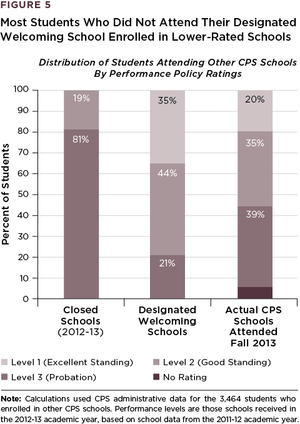1. What are the characteristics of the students affected by school closures?
2. Where did displaced students enroll the following fall?
3. Why did families enroll their children into designated welcoming schools?
4. Why did families enroll their children into other Chicago Public School (CPS) schools?
Nearly all students displaced by Chicago's 2013 mass school closure enrolled in schools with better academic ratings than their closed school. However, only one-fifth landed at top-tier schools and nearly one-quarter went to schools that were lower-performing than the welcoming schools assigned to them by the district. This report tracks the enrollment patterns of nearly 11,000 students required to transition to a new elementary schools after the closings. It also draws on interviews with parents to understand how they navigated the enrollment process and why some students ended up in their assigned school while others ended up in schools that were higher- or lower-rated than those assigned to them by the district.
Click below to view a 90-second episode of GO FIGURE, with Marisa de la Torre explaining Figure 4 of this research (October 31, 2023).
Key Findings
- Nearly all displaced students ended up in schools with higher performance ratings than the schools they had previously attended (93 percent), though most of these schools were not substantially higher performing. While most displaced students did end up in schools with better performance ratings than their previous schools, more than one-third remained in schools designated Level 3, the district’s lowest rating. Just 21 percent ended up in Level 1 schools, the district’s top rated schools. Prior research from the UChicago Consortium found that only displaced students who ended up in substantially higher-performing schools (the top quartile in the district) saw improvement.
- One-third of students did not enroll in district-designated welcoming schools. Of these, more than half landed in schools that were lower-rated than those assigned to them by the district. Because the district targeted most of their transition plans to the welcoming schools, these students also missed out on the extra resources given to the welcoming schools.
- Proximity to home was the deciding factor in most enrollment decisions. Whether they enrolled in a designated welcoming school, a higher-rated school, or a lower-rated school, most families based their decision first and foremost on location. Indeed, students traveled about the same distance from home whether they attended a high- or low-rated school, suggesting that parents chose higher-rated schools primarily when they were nearby. Although parents were seeking schools that met their children’s academic needs, they also felt compelled to choose a school in their neighborhood, oftentimes because of safety concerns. Finding a school close to home was not simply about convenience but also about practical circumstances and realities, including access to a car and work schedules.
- For many families academic quality meant something different than a schools' performance policy rating. The way that many parents defined academic quality was different than the official markers of quality represented by the district’s performance policy rating system. For example, many families defined academic quality as having after-school programs, certain curricula and courses, small class sizes, positive and welcoming school environments, and/or one-on-one attention from teachers in classes. Although some families did talk about their school’s official policy rating, most factored in these other "unofficial" indicators of academic quality when making their school choice decisions.






